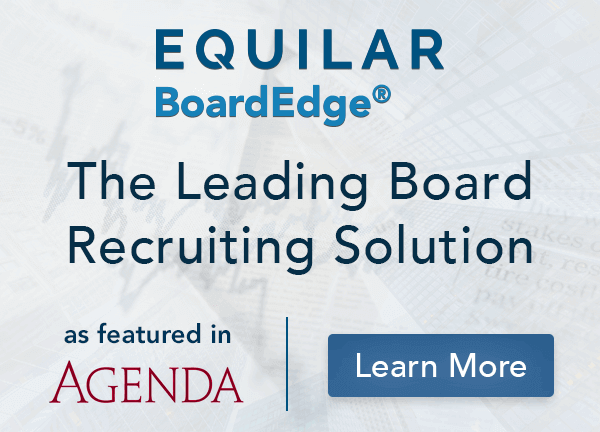Equilar Institute
Blog Home
Stop Talking About a Board Refresh and Make It Happen—Like Forrester
By Coco Brown, founder & CEO, The Athena Alliance

April 2, 2019
The business world looks almost nothing like it did a decade ago. Every business is digital. Businesses today exist without walls and without borders. Cybersecurity is now a paramount concern, regardless of an organization’s size or location. And consumers and employees hold more power than ever, as they choose to go to companies that don’t just have products they love, but share similar values.
Yet despite these massive changes and growing macro trends, there’s one aspect of the business world that has been slow to change: the boardroom. The imperatives that companies face today are strikingly different than yesterday, yet many boards still look like they did when brick and mortar stores ruled the world, when digital transformation was a seemingly far off prediction, and when the hot topics in the boardroom revolved around audit and compliance.
Organizations that feel like their current boards are no longer current must ask themselves: Is it time for a board refresh?
Key Takeaways
-
Board directors are under increasing pressure to contribute, even from their director peers.
-
Boards are re-evaluating their competencies and structure, leveraging tools such as a skills matrix.
-
Forrester Research, Inc. recently made the bold and proactive move of undergoing a board refresh. Read on to see how (and why) they did it.
Every director must contribute
Shareholders and broader communities have increasingly voiced concerns regarding board composition, such as slow board director turnover, long director tenures and the outdated skill sets of many directors. In one survey to investors, 68% of respondents said long tenure is a cause for concern, and 53% of respondents said no recently appointed independent directors is a cause for concern.
But it’s not just investors and communities who are concerned. Directors themselves have taken notice of the need for change. PwC’s 2018 Annual Corporate Directors Survey notes that: “The demand to stay on top of new technologies, an increasingly interconnected world and a constantly changing business landscape means that every seat in the boardroom needs to be filled by someone who is genuinely contributing.” PwC’s report found that:
-
45% of directors believe that at least one person on their board must be replaced
-
21% of directors feel that more than one director must go
-
12% of directors say their board peers lack the appropriate skills and expertise
-
10% of directors say the advanced age of their board peers has negatively impacted their peers’ performance
A pressure to diversify
Additionally, there’s been a recent spotlight on the lack of diversity in many corporate boardrooms. Leading the conversation is investment firm BlackRock, which is actively calling out companies that have no women on their boards.
The firm’s view: “Irrespective of a company’s industry, location or size, we believe that a lack of diversity on the board undermines its ability to make effective strategic decisions.” The firm has called for all companies in which it invests to have at least two women on its board.
The state of California, too, made a radical move when it recently approved HB 826, a bill that requires public companies headquartered in California to have at least one woman on their board of directors. Companies must comply by the end of 2019.
A fresh look at competency and imperatives
Despite these statistics, cronyism continues to exist across boardrooms for companies of all sizes. The appointment and recruitment process for new directors is extremely ambiguous. Positions are not publicly posted, shareholders have no say, and current directors tend to recruit those in their inner circle. Plus, there’s no structure in place to enforce board refreshes. Policies such as realistic term limits and evaluation processes largely do not exist, or when they do are often worked around.
In today’s world, where consumers and investors demand transparency, it’s becoming increasingly difficult for organizations to sidestep a board refresh. Take UPS, for example. The shipping company made mainstream headlines when activist investors called it out for its numerous long-tenured board directors. Headlines such as this are sure to become more common as more companies get called out for refusing to update their boards to more clearly reflect modern business trends, opportunities and threats.
To undergo a refresh, look at your competency and imperatives
A refresh ensures the board of directors is current and in line with contemporary business trends. It sets the expectation that board members should have relevant, recent experience; that they should reflect the demographics of the community it serves; that the board remains relevant and current, and congruent with the organization’s top imperatives.
A refresh does not mean that all board directors retire. It’s a decision on the board and CEO’s part to focus on the competency and critical skills that the business requires to take it to the next level. It’s an agreement on behalf of both CEO and board that there are major vulnerabilities on the board; that there are blind spots that can’t be risked.
This may mean that new seats are added, that current directors get replaced, or that a combination of replacing and adding directors occurs. A board must evaluate its current skills and compare it to the ones it is missing. For example, if a board has five CEOs with financial expertise, then the board may need to create space for directors who can bring other areas of expertise to the board. These areas of expertise may be specific to certain industries, businesses, technologies or even geographies.
One way to gain clarity on a board refresh is a skills matrix. Using a matrix, a board can outline key areas of competency that they must cover across their directors, such as audit, compensation, governance. They can also outline three to five key imperatives—the most relevant imperatives that the business faces, the ones that can spark tremendous, transformative growth. For one business, this may mean expansion into China; for another it could be dominating an entirely new vertical; for another it may be a sweeping cultural overhaul. A matrix makes these blind spots clear.
The Forrester Research board refresh: “It took some level of courage”
One organization that recently took on a refresh was Forrester Research, Inc. They made proactive, sweeping changes in the spirit of continuous improvement.
Rob Galford is a seasoned director who sits on the board of Forrester, where he is Lead Independent Director. The idea of a board refresh arose at a time when Forrester hadn’t had turnover in more than a dozen years. The issue came up in conversations between Rob and George Colony, Forrester’s CEO and Chair of the Board.
“It takes some level of courage to do a refresh,” Rob admits. “George is the type who is constantly looking for improvement—continuous improvement. He values different perspectives and new perspectives, and this includes the boardroom.”
George and Rob began the board refresh process by considering just how quickly they could make it happen. The goal: move fast, without being destructive. The conventional road says refreshes should be done slowly; it takes time (sometimes several years) to find the right fit.
“We looked at it this way: If you were changing your business strategy and making what you believed to be positive changes, would you change it one drop at a time? No. If you wouldn’t do that with your business strategy, why would you do that with your board?”
A steady pace towards progress was important to George and Rob, as they felt their actions—or lack of action—on a board refresh demonstrated their level of commitment to the overall process. They wanted to put meaning behind their desire for change. They didn’t just want to think strategically; they wanted to act strategically.
And so, in Rob’s words, they “threw gradual planning out the window. It was time to be bold.”
A new perspective on board composition
And move fast they did. Within a year, Forrester retired three of its directors and added five new directors. The process began with a broader discussion with the entire board of directors. The broad question posed to each: what is important to this board, and what is important to this organization?
Forrester gave thought to the critical skill sets they needed to be successful in the future. What level of expertise do they need on the board to help them achieve their goals, and in what functional areas? What issues are most important to the organization now and going forward? To help reveal these answers, individual conversations were had with each director. These conversations helped craft the ideal profiles of future directors.
Until this time, Forrester’s board had historically been centered on directors who were located in the Northeast, mostly males of similar age, and hailing from Ivy League schools.
“We realized our board composition was not sufficiently reflecting our company’s full target demographic. And it certainly didn’t reflect our broader community,” Rob says.
In their search, Forrester proactively sought at least one international board member. And they wanted to be active in their search for women, including younger women, and those not necessarily from the Northeast. They also opened up their search to focus on the west coast and to technology expertise.
The big picture
“I recognize that many people may be in favor of a board refresh, conceptually. But there are not many people who will raise their hand and remove themselves,” Rob reflects.
However, for Forrester, Rob says no animosity existed in the room when discussing a refresh. While no one is going to be thrilled that their board service is coming to an end, there was no resistance. Members took a more philosophical approach to the discussions, truly putting the board and the business in front of their personal ambitions.
Throughout the course of a year, Forrester added five new members to its board and retired three members. Athena partnered closely with National Association of Corporate Directors (NACD) to place our member, Yvonne Wassenaar on the Forrester board. Yvonne is a revolutionary technology executive and current advisor to Snyk, an open source security platform based in the UK. As former CIO to New Relic and former CEO to Airware, a venture-funded drone startup, Yvonne delivers contemporary perspectives to Forrester on modern business and technology risks and opportunities.
“The transition went quite well,” Rob said. “It’s not to say that the risks are overrated but if you’re thoughtful about this, you quickly realize there are far greater challenges that boards face. The process was not nearly as bad as one might fear. In fact, George would say, ‘Quite the contrary. It has given us a better board, which makes us a better company.’”
About Athena Alliance
Athena Alliance is revolutionizing leadership, from senior management to the boardroom. We enable businesses to take on today’s greatest threats and to conquer their most pressing imperatives. And, we empower women to own their value and to step into their most ambitious leadership role yet: in the boardroom, in the C-suite, as a founder, or as an investor. At the heart of our mission: coaching remarkable senior women leaders to fully own their value and to step into bigger roles. We also guide CEOs, venture firms and corporations to evolve their approach to senior leadership development, to strengthen their boards, and to facilitate curated connections to remarkable female leaders. Learn more at: www.AthenaAlliance.org.
Athena Alliance is an Equilar Diversity Network partner. The Equilar Diversity Network is a consortium to advance diverse representation in boardrooms across the globe. Visit https://www.equilar.com/diversity.html to learn more.
About Coco Brown
Coco Brown is the founder and CEO of The Athena Alliance. She leads a network of more than 1500 C-Level women, VCs, and CEOs from over 200 companies including Microsoft, Autodesk, Intuit, OpenView Venture Partners, Accenture, TA Associates, and PwC. Coco has extensive experience in serving as an advisor to C-suite executives and their teams, guiding strategy and execution. Prior to The Athena Alliance, Coco served as President, COO and Board Director of Taos, a prominent IT Services business serving hundreds of F1000 companies such as Apple, Cisco, ebay, Facebook, and Silicon Valley Bank.
Coco Brown, Founder and CEO of The Athena Alliance, authored this post. Please contact Amit Batish, Content Manager, at abatish@equilar.com for more information about this article.
 Solutions
Solutions











